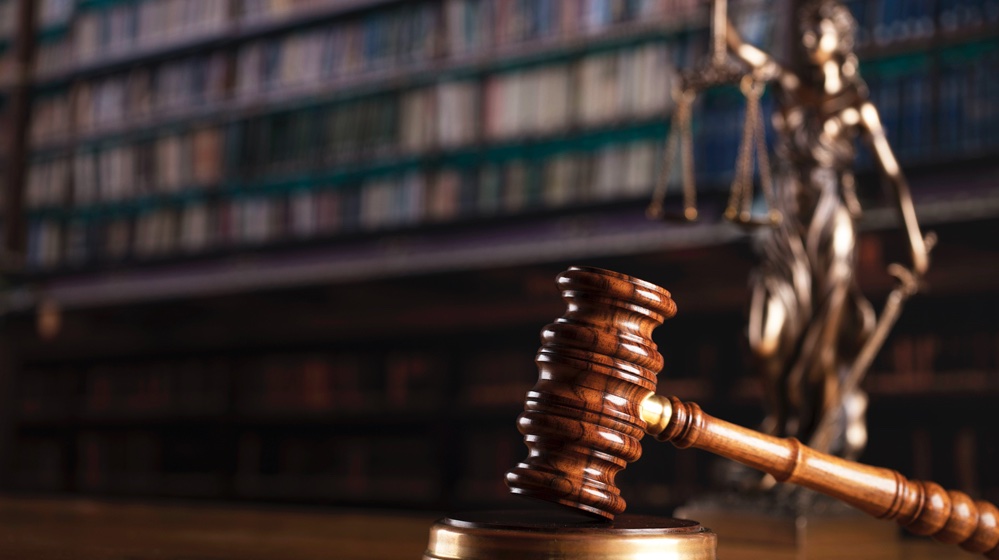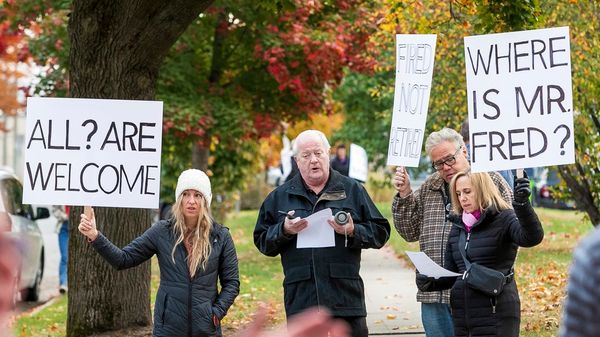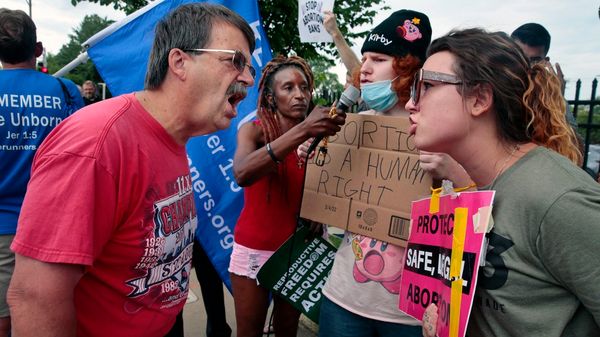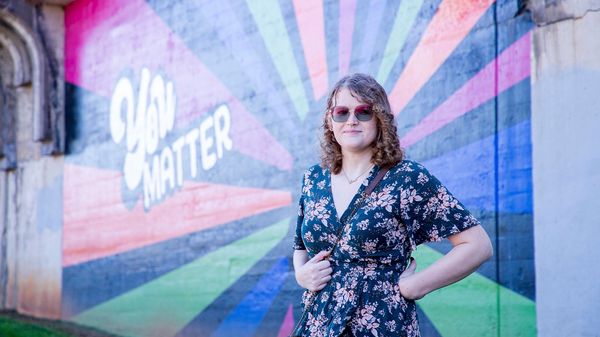
April 8, 2017
Gilbert Baker, Rainbow Flag Creator, Dies
Seth Hemmelgarn READ TIME: 7 MIN.
Gilbert Baker, the creator of the iconic rainbow flag that's become an international symbol for LGBT rights, died March 31 at his home in New York. He was 65.
Mr. Baker, often called the gay Betsy Ross for his role in coming up with the first flag almost 40 years ago, is being mourned by friends and admirers in San Francisco, where he once lived, and around the country.
According to Julie Bolcer, a spokeswoman for the New York City medical examiner's office, Baker's death was reported to the agency Friday, March 31.
"The cause of death is hypertensive and atherosclerotic cardiovascular disease," Bolcer said in an email.
Cleve Jones, a longtime gay activist and friend of Mr. Baker's, said in a phone interview that Mr. Baker "suffered a massive stroke six and half years ago and was able to teach himself how to sew again, but it affected his day-to-day life from then on, and I was quite concerned the last time I saw him. ... He complained about being in a fair amount of discomfort."
Mr. Baker himself recalled the stroke in a 2012 interview with the Bay Area Reporter.
"It really fucked me up," he said. "For three months I couldn't see or walk. I'm a strong guy and I recovered, but it changed me. It made me think about dying, it gave me pause to think that every life is finite. It made me appreciate the ones who came before me who did so much great work."
Jones said that he first met Mr. Baker around 1974.
"He was such a diva," Jones said. "He was so outrageous and sometimes quite ridiculous. ... We had a lot of wonderful times just dreaming up crazy stuff to do" to shock, amaze, or even outrage people.
Jones recalled the year that Mr. Baker famously marched in the city's Pride parade as "Pink Jesus." Mr. Baker, with his body covered in hot pink and little else, donned high heels and carried a cross down Market Street.
"He was quite crazy, and he had epic fights with his other Sisters of Perpetual Indulgence," Jones said, noting that Mr. Baker belonged to the charitable group of drag nuns as Sister Chanel until 2001.
There was more to Mr. Baker than just antics, however, Jones said.
"What many people might not know about Gilbert was how extremely intelligent he was," he said. "He'd read a lot, and he knew a lot about history."
Asked about what motivated Baker, who was also an Army veteran, Jones said his friend "grew up in a very conservative family and a very conservative part of Kansas."
The problems that Mr. Baker experienced growing up "drove his desire to change the world and the way gay people are treated," Jones said. "...Beneath the bravado and the bitchiness was a deep compassion, and when AIDS came and so many of our friends died so horribly, he was a part of caring for an awful lot of people."
Need for A Symbol
Jones wrote about Mr. Baker and the creation of the rainbow flag in the late 1970s in his memoir, "When We Rise." The book was partially the inspiration for the recently aired TV miniseries of the same name created by Academy Award winner Dustin Lance Black.
"There was truly a conversation going on at the time about a need for a symbol," Jones said of the period when the flag was created.
The Greek Lambda symbol was one option, but "people would say, 'What does that mean?' Nobody really knew," Jones said, adding, "... I still don't even really know the answer to that."
The pink triangle, which the Nazis had used to label homosexuals in concentration camps, was another possibility.
"A decade later, it would be transformed by ACT UP into a powerful symbol of resistance, but at the time we're talking about, it was a symbol from the death camps," Jones said, recalling that people like gay rights icon Harvey Milk, the city supervisor who was a friend of Jones' and Mr. Baker's before his assassination in 1978, were also part of the conversation.
Finally, Mr. Baker thought of the flag idea, and Jones said in the summer of 1978, he helped Baker dye the fabric for it at 330 Grove Street, the site of San Francisco's old LGBT community center.
"We made quite a mess, and Gilbert created the first two flags," Jones said.
One flag had eight colored bars, and the other had eight bars with tie-dyed starbursts, somewhat resembling an American flag.
The flags were "raised on two enormous flagpoles in United Nations Plaza. I remember that quite vividly," Jones said.
As the flags were raised, "the wind kicked up, and they unfurled" as marchers, in what was then known as the Gay Freedom Day Parade, approached on Market Street. As people gathered under the flags, "their faces lit up," Jones said. "Everyone knew immediately that this was our flag."
Dan Nicoletta, who's spent decades photographing LGBT history and first met Mr. Baker around 1977, also remembered seeing the flags that day, calling them "breathtaking."
Nicoletta pointed out that Mr. Baker didn't create the flag on his own.
"He had a core group of people that were his collaborators. ... In a sense, he was always considered this symbolic point person for all that, but we worked very communally back then," Nicoletta said.
"I think he would want that record to be set straight."
A flag collaborator who Nicoletta shared contact information for didn't respond to an interview request.
Arrival in San Francisco
According to Mr. Baker's biography, he was born in Chanute, Kansas, on June 2, 1951. He served in the U.S. Army from 1970-1972, and he was stationed in San Francisco just as the gay liberation movement was getting underway in the city.
In 1994, Mr. Baker moved to New York City, where he made a mile-long rainbow flag to mark the 25th anniversary of the Stonewall riots. The flag broke the record for the world's largest flag. He surpassed that record in 2003, the 25th anniversary of the rainbow flag, by creating one that stretched "from the Gulf of Mexico to the Atlantic Ocean in Key West," according to his biography.
Mr. Baker recently completed a nine-color rainbow flag that added the color lavender, for diversity, to go along with the original colors: hot pink represented sexuality; red, life; orange, healing; yellow, sunlight; green, nature; turquoise, magic/art; blue, serenity/harmony; and violet, spirit. The common rainbow flag seen today has six colors - the hot pink and turquoise were left off.
His explanation for why he chose a rainbow design is simple.
"It fits us," he explained in 2012. "We're all the colors, all the sexes, all the genders. Infinite people. Infinite colors."
In an interview Friday, gay former San Francisco Supervisor and state Assemblyman Tom Ammiano said Mr. Baker "made an impact, and it's very artistic and visual."
Numerous rainbow flags and banners adorn the Castro neighborhood, and Ammiano noted that the flags line Market Street every June for Pride Month.
"We always think of him, so that's going to be his legacy every time we look at the rainbow flag," Ammiano said.
Another aspect of Mr. Baker's life "that gets lost" is that besides flags, Mr. Baker also made "outrageous costumes and gowns and dresses," Jones said. "He dressed hundreds of drag queens over the decades. ... He was constantly turning out massive, beautiful banners march after march after march."
Jones said, "I have in my possession what I think is the last banner he made. He brought it out here for 'When We Rise.' It's a giant rainbow with 'Rise and Resist' on it."
The banner was unfurled at a gathering for Mr. Baker at Harvey Milk Plaza Friday night, beneath the large rainbow flag that's looked over the Castro for decades and was lowered to half-mast for a time.
Recalling his friend's work, Jones teared up as he explained that he was holding the bag that Mr. Baker had brought the banner in.
"When we pulled that out, there was popcorn in the bag," from when he and Baker had sat in the back of the Castro Theatre watching the "When We Rise" premier.
"I'm just grateful that he got to see that, and he knew then that his legacy would be known, that a younger generation would know about this," said Jones, who said he's received thousands of messages about Mr. Baker from young people who are "glad to know this part of their history."
He said that when people see the flag, it often "doesn't occur to them to wonder where does that come from. ... It matters to know that there was this generation of people who said to themselves, like Gilbert did, 'We need a symbol. We need a flag.' "
According to Mr. Baker's biography, the rainbow flag is in the public domain, as are all flags, and he did not profit from its usage as a commercial product.
Mr. Baker is survived by his mother, Patricia Baker, and a sister, Ardonna Baker Cook.
"Our family is extremely grateful for all of the condolences and support we have received on behalf of Gilbert's passing," the women said in a statement. "He will be dearly missed by his family, friends, the art world, as well as the entire LGBTQ community. He led a bold and inspiring life by bringing the rainbow flag to the world and teaching others about the beauty in diversity."
Plans for a public memorial are pending.
City Hall was lit up with rainbow lighting Tuesday night in honor of the San Francisco Symphony Pride concert and to honor Mr. Baker.
Gay state Senator Scott Wiener (D-San Francisco) adjourned the Senate session Monday in memory of Mr. Baker. To view Wiener's presentation, see https://www.youtube.com/watch?v=CVunenX-DTc&feature=youtu.be







